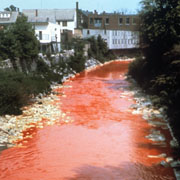
The referenced media source is missing and needs to be re-embedded.
By Marion Stoddart and John Duff, Guest Writers
This is the second in a series of posts celebrating the fortieth anniversary of the landmark Clean Water Act. Check back each day for the latest installment.
In early 2012, Department of the Interior Secretary Ken Salazar announced “America’s Great Outdoors Rivers Initiative,” an effort to protect and restore America’s rivers for people and wildlife and to support jobs in tourism and outdoor recreation. This is good news, because rivers— and oceans— are our lifeblood and need ongoing care. Thanks to the Clean Water Act, passed in 1972, it’s now possible to swim and fish in many rivers and seas that were extremely polluted only a few years or decades ago. The 40th anniversary of this key legislation is an ideal time to reflect on progress we’ve made, as well as the work that remains.
As human societies settled some lands and set out to explore others they did so relying upon our waterways. Native Americans and American colonists fished and travelled upon the waters and founded settlements on the shores of life-sustaining rivers, lakes, and oceans. On July 4, 1776 we articulated our connection and concern when the founders charged King George III with “plunder[ing] our seas, [and] ravag[ing] our coasts.”
The referenced media source is missing and needs to be re-embedded.
Yet our own stewardship has wavered over the decades. In the eighteenth and nineteenth centuries we used and took from our rivers and ocean spaces presuming that they would always support us. But as the nineteenth century came to a close, we realized that we had used our waterways as disposal systems for so long that we were degrading their “condition and capacity.” In 1899, Congress enacted the Rivers and Harbors Act to protect the navigability of our waterways.
In the twentieth century, our population grew, our technology developed and our demands on rivers and seas increased. The results of amplified, unmonitored use were disturbingly apparent in the 1960s as our rivers changed color and viscosity and in some cases burst into flames. Citizen activists gathered once again, not to rebel but to reform the way we used our waterways.
The Nashua River, which had been dubbed one of the top ten most polluted rivers in the country, was just one example of conditions around the country. After several years of grassroots activism, the fledgling Nashua River Watershed Association was officially formed in 1969, and it became a federally designated model for other water protection associations. We worked diligently to find common ground among competing interests; we convened residents, business owners and lawmakers along the Nashua River to show them what was and remind them of what we had lost. We built political will that lawmakers could rely on, to pass a clean water law in Massachusetts that was the first such law in the nation, serving as a model that would ultimately apply throughout the United States. And we restored the river so that today it is a vital natural resource for wildlife and people.
Across America, there have been similar stories of environmental advocates, industrialists, civic leaders and state, federal and local policymakers joining together so that people can boat, swim and fish in rivers and bays that were deemed unsafe a generation ago. But the benefits derived from the Clean Water Act depend on continual stewardship. Indeed some waterways still have a long way to come to recover from past lapses. The Environmental Protection Agency estimates that about a third of the nation’s waters are still unhealthy. The Clean Water Act has more work to do. We can’t think of another instance where people can literally immerse themselves in the results of sound national policy.
After a period of successful treatment, we may be tempted to let our prescription run out, to let our behavior slide back. Let’s guard against relapse. We can bring back more stretches of our rivers and coasts to amaze ourselves and provide our children and grandchildren with the wonders of our waterway connections. The fact that we’ve made progress does not mean the threats have disappeared. The good news is there are more and more groups engaged in water education and recreation. Jump right in. Teach a child to swim. Learn how to kayak or canoe.
Go back to the water. Be respectful. Be rewarded. Celebrate our oceans and rivers on their day, during their month and all year long. Remind your neighbors, friends and representatives what our rivers and coasts mean to us all. Get involved in efforts to ensure that the memories you have are possibilities for others this summer and in the years to come.
See you on the water.
Marion Stoddart founded the Nashua River Watershed Association in 1969, and is the subject of the award-winning documentary film, “The Work of 1000.” John Duff, J.D., LL.M., is an associate professor in the Environmental, Earth & Ocean Sciences Department at the University of Massachusetts BostonRelated Posts
Stay Informed
Get the latest updates and actions:
Thanks for signing up!
There was a problem processing your signup. Please try again.


